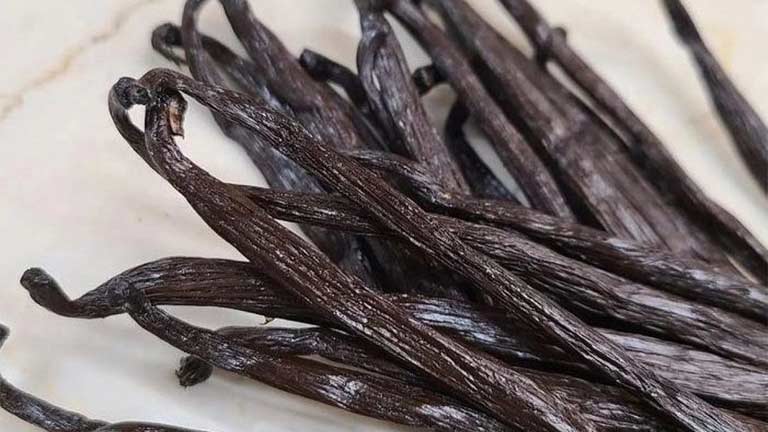
Vanilla is a culinary gem that is recognized and appreciated all over the world due to its unique flavor and aroma. The bean itself contains the true essence of vanilla, even though vanilla extract is a frequent pantry staple. These enchanted pods are the fruit of the vanilla orchid, which is greatly admired for the excellent flavor and aroma that they possess. This piece will delve into the world of vanilla beans and examine six essential factors that you need to be aware of to develop a deeper appreciation for this magnificent ingredient.
Types Of Vanilla
Bourbon vanilla and Tahitian vanilla are two of the most well-known varieties of vanilla beans. They are typically referred to as Madagascar vanilla. Bourbon vanilla is derived from the Vanilla planifolia orchid, which is principally cultivated in Madagascar, Comoros, and other islands in the Indian Ocean. The flavor characteristic of this type is described as being rich and creamy, with overtones of chocolate and caramel that are understated. On the other hand, Tahitian vanilla, which is derived from the orchid known as Vanilla tahitensis, is mostly cultivated in Tahiti and the islands that are located nearby.
Harvesting and Pollination
The journey of vanilla beans begins with the vanilla orchid’s delicate flowers. These flowers are special, but they need a bit of help to become vanilla beans. Skilled farmers carefully pollinate them by hand, which is like giving the flowers a gentle nudge to start growing beans. This process is very detailed and needs a lot of care. After the pollination magic happens, the beans take their time to fully mature, and this takes several months. It’s like waiting for them to grow up! Once the beans are ready, farmers can then harvest them. So, it’s a patient and skillful process from the flowering orchids to the vanilla beans we love in our desserts and drinks.
Evaluation Of Vanilla
These beans are graded according to their quality, appearance, and the amount of moisture that constitutes their overall composition. The most prestigious grade is Grade A, also known as “gourmet” vanilla, which is distinguished by beans that are full, juicy, and glossy. Despite being slightly drier and less visually pleasing, Grade B, which is frequently referred to as “extraction grade,” is an excellent choice for the production of vanilla extract. Grade C, also referred to as “vanilla cuts” or “vanilla powder,” is a mixture of broken and dry beans that is largely utilized for commercial purposes, such as adding flavor to beverages and confections.
Correct Storage
It is vital to store vanilla beans appropriately to maintain their potency and freshness. Vanilla beans can be kept in a container that is airtight and protected from direct sunlight, heat, and excessive moisture whenever they are stored. A large number of fans favor storing vanilla beans in a glass jar that is hermetically sealed and has a lid that fits snugly. These beans have the potential to maintain their viability for several years if they are stored appropriately. Some enthusiasts believe that the flavor of beans may even increase with age.
Extraction Of Beans
The extraction of vanilla beans is a fascinating process that involves infusing the distinctive flavor and scent of the vanilla into a liquid, which is commonly alcohol. To make your vanilla extract, split vanilla beans lengthwise, scrape out the tiny seeds, and then drop the bean pod and the seeds into a bottle of vodka or rum. For many weeks, the combination can be allowed to sit in a cold, dark environment, with the bottle being shaken periodically. Your handmade vanilla extract will soon be ready for use in a variety of dishes, and it also makes for a pleasant and considerate present idea for other people who have a passion for cooking.
Alternate Cuisines Available
Vanilla beans are an extremely versatile ingredient that may be used to enhance both sweet and savory meals. During the baking process, they provide cakes, pastries, and custards with a flavor that is opulent and sumptuous. Additionally, you can make mouthwatering desserts that use vanilla, such as panna cotta, crème brûlée, and ice cream made with vanilla beans. These beans can be used in savory cooking to enhance the flavor and complexity of marinades, sauces, and even seafood dishes. The tremendous value that they provide to the kitchen is demonstrated by the fact that they may be utilized in a variety of different culinary settings.
Conclusion
Vanilla beans are one of the most valuable ingredients in the culinary world, as they can take your culinary creations to new heights. If you have a comprehensive awareness of the complexities of vanilla beans, you will be able to unlock the full potential of this remarkable ingredient. These six essential insights will enable you to harness the genuine essence of vanilla and infuse it into your culinary masterpieces with grace and flare. From selecting the appropriate variety to storing it properly and sourcing it responsibly, these insights will empower you to capture the essence of vanilla.




